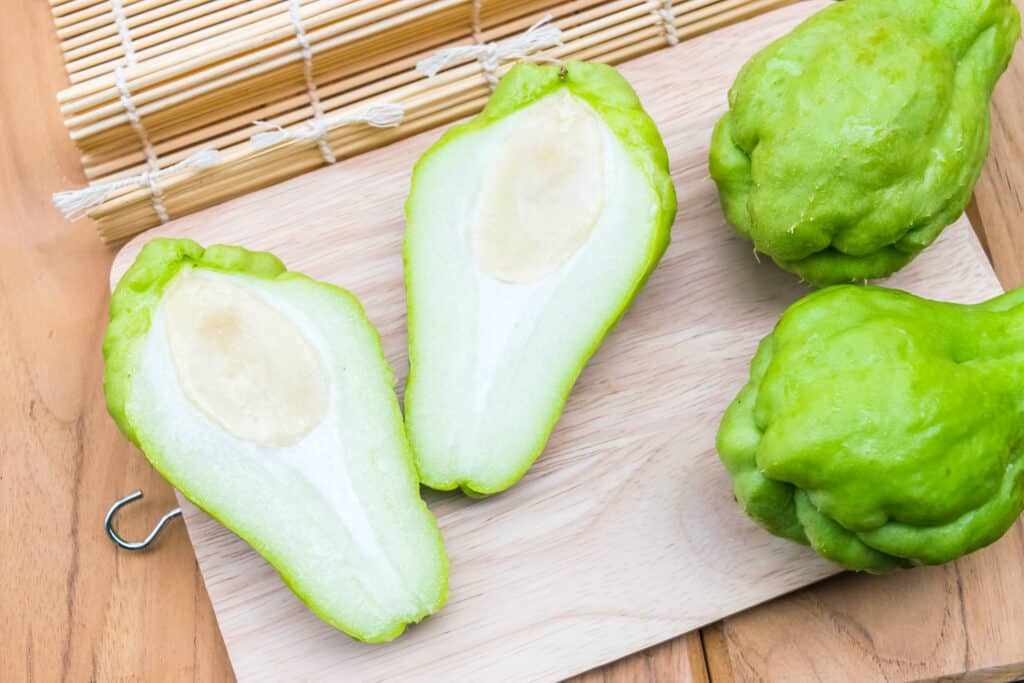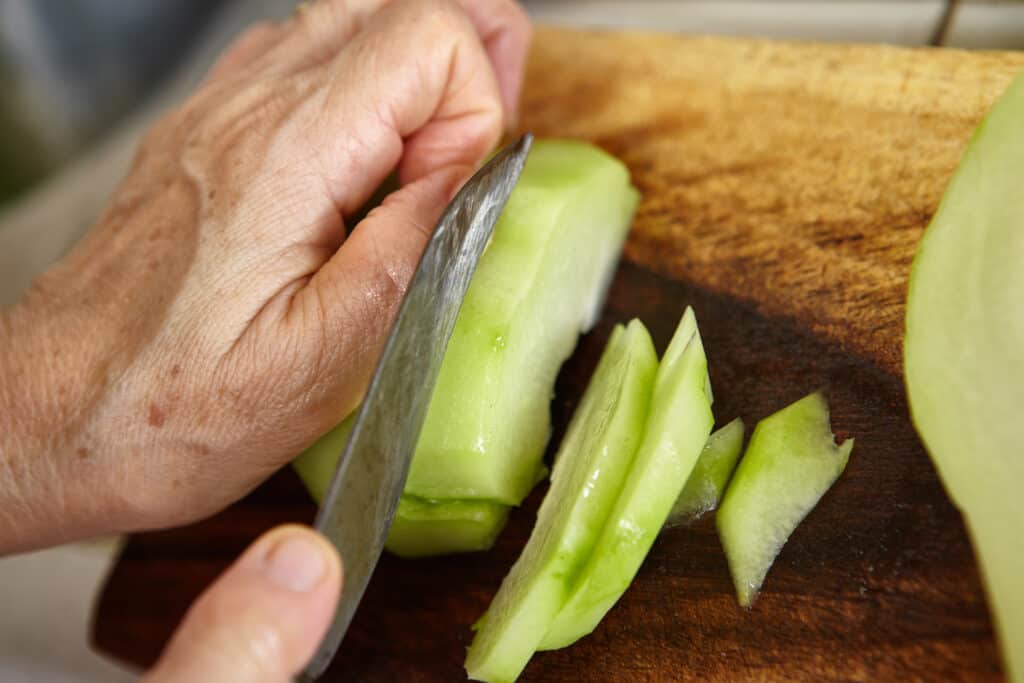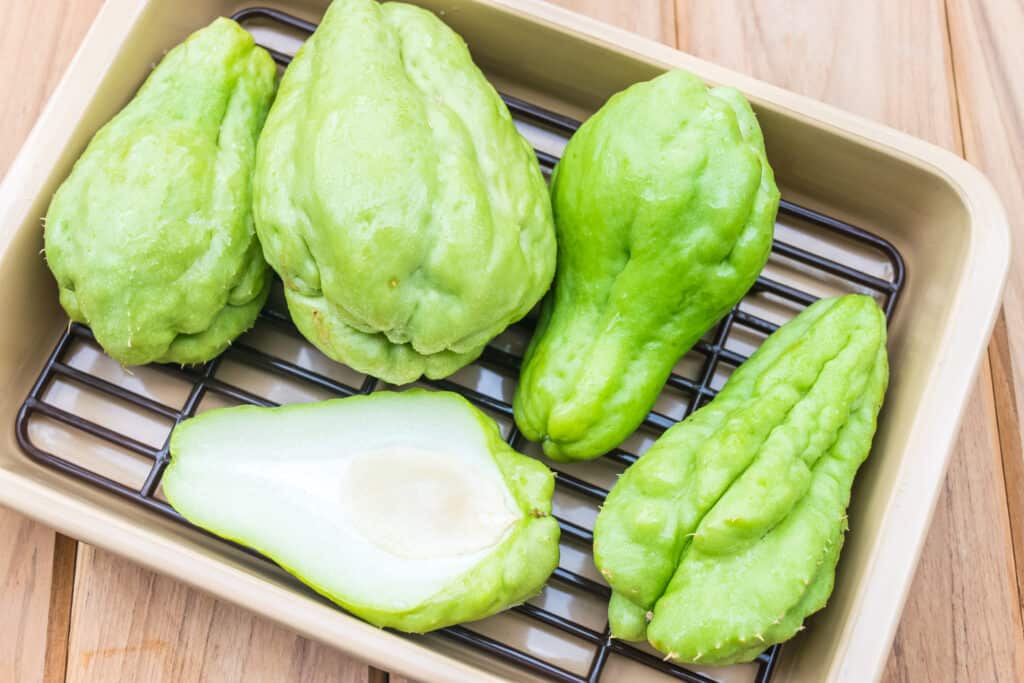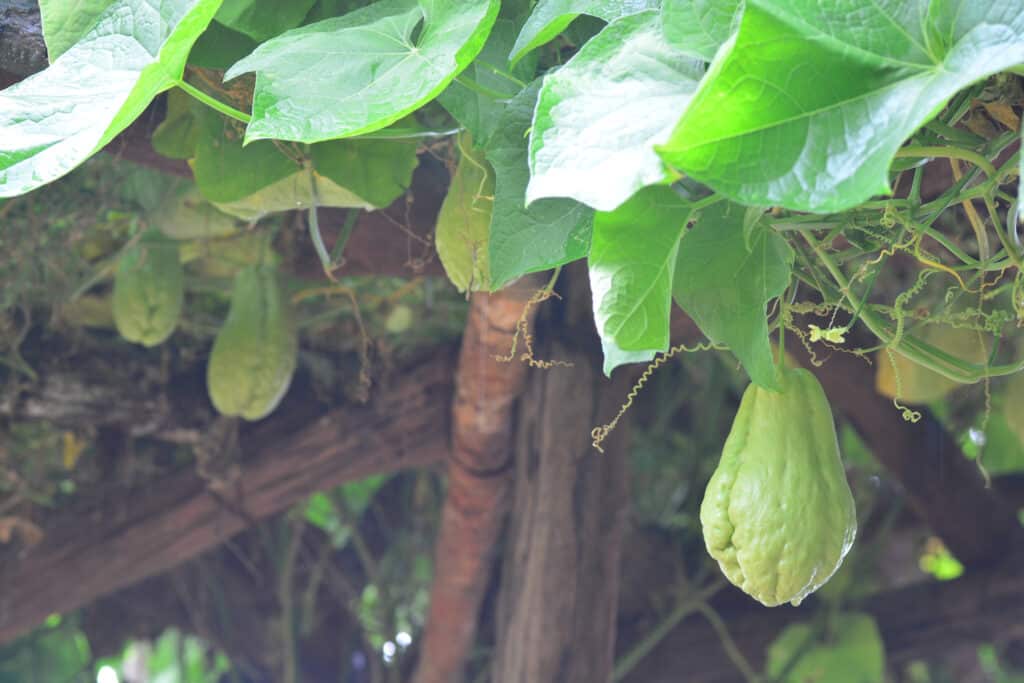Young and tender chayote can be served finely sliced raw in salads, or it can be served puréed, or diced in soups or stews, or sautéed, steamed, boiled, stir-fried, deep-fried, and baked.
Chayote has a mild cucumber- to apple-like flavor and crunch and can be prepared just as you would a summer squash.

The mild flavor of chayote allows it to be served alone with just butter or cream or to be spiced up with assertive seasonings such as lime juice, cinnamon, or nutmeg. Add sugar or brown sugar and chayote can be served as a dessert.
Kitchen Helpers from Amazon:
- Oster Vegetable Steamer
- Chef’s Knives Set of 6
- EZ Off Jar Opener for Weak Hands
- Pepper Core Remover Stainless Steel
- Kitchen Utensils – Set of 35
- Rachel Ray Non-Stick Cookware 12pcs
How to choose chayote
- Select chayote that is small, firm—but not too hard–and unblemished. Very hard-skinned chayote can be fibrous. Smaller chayote will be tender.
- Avoid fruits that are sticky or discolored.

How to prep chayote for cooking
- The skin of chayote can be eaten if it is tender. Test it before you cook it. The furrowed skin of mature chayote can be covered with small hair-like spines and should be peeled before eating or cooking.
- The flesh of the chayote will remain firm if the skin is left on during cooking. You can peel chayote before or after cooking, but if you peel it before it may secrete a sticky substance that might irritate your skin. This substance disappears during cooking.
- To peel chayote before cooking, wear gloves or oil your hands or peel under running water.
- Chayote is not fully ripe until it starts to germinate, then a sprout will emerge from the stone and grow out through the stem end. Overripe chayote is used in Creole-style dishes.
- If chayote over-ripens, scoop out the flesh, remove the seed, mash the flesh with cheese or meat and re-stuff it for baking.
Chayote serving suggestions
- Chayote can be served as you would summer squash raw or cooked. Chayote can replace summer squash in most recipes.
- Serve it young, tender, and raw added to salads. Peel, core, finely slice, and serve with a light vinaigrette.
- Cut raw into julienne strips and add to coleslaw-type salad.
- Add sugar or lime juice, cinnamon, and nutmeg to serve as a dessert.

Chayote cooking suggestions
- Cook chayote like you would cucumber or zucchini. Serve it puréed in cream, steamed and sliced in a light salad, or sautéed with butter and herbs to appreciate its delicacy.
- Serve simply cooked still slightly crisp. Allow 10 to 15 minutes for boiling or steaming.
- Add to soups, stews, stir-fries, marinades, pickles, and chutneys. Remove the outer skin to sauté or deep-fry.
- Blend with seafood or ham in soup, stir-fry, casserole, or fried.
- Cook topped with a sauce au gratin.
- Split, stuff, and bake like acorn squash. The empty skin can be partially cooked before re-stuffing. Stuff with fillings such as seafood, ham, pork, ginger, and scallions.
- Half and stuff with raisins, nuts, brown sugar, and eggs.
- Young chayote shoots can be eaten like asparagus.
- The chayote seed can be cooked and has a taste somewhere between lima bean and almond.
Chayote flavor partners
- Chayote can be partnered with chicken, chiles, cilantro, corn, ham, lime, onions, seafood, sweet peppers, and tomatoes.
Chayote nutrition
- Chayote is a good source of potassium and contains vitamin C, folic acid, vitamin B, copper, and magnesium.
- Chayote is low in calories, about 40 per cup.

How to store chayote
- Chayote will keep in the refrigerator in a plastic bag for four weeks or so. Lightly wrap it in a paper towel before placing it in a plastic bag.
Get to know chayote
- Chayote—pronounced chi-OH-tay—got its start in the tropics and semi-tropics of Central America but grows in temperate regions where the weather remains mild and warm in the fall and winter.
- Chayote is an annual gourd-like vegetable that grows on a vine to about the size and shape of a pear–3 to 8 inches (7.5-20 cm) long. On average the chayote weighs about half a pound (225g). Its skin can vary in color from yellowish-white to pale green to dark green.
- The flesh of the chayote is firm, crisp, and whitish. Each fruit contains a soft stone that is 1 to 2 inches (2.5-5 cm) long. Both the skin and stone of the chayote can be eaten when cooked.
- The flowers and tuberous roots of the chayote can be eaten as well.
- Chayote is native to Mexico and Central America, but it now grows in the West Indies, South and Central America, India, North Africa, Indonesia, New Zealand, and Australia. In the United States, chayote is grown in California, Florida, and Louisiana where it is known as mirliton.
- In France, chayote is known as christophene; in Great Britain as custard marrow; in Brazil and West Africa as chocho; and in Vietnam as xuxu.
- Chayote was originally cultivated by the Mayans and Aztecs. Its name is derived from chayot—the Nahuatl word for vegetable. Nahuatl was the language of the Aztecs.
The botanical name for chayote is Sechium edule.
Also of interest:
Related articles:
Best Herbs for Container Growing
Garden Planning Books at Amazon:
- Vegetable Garden Almanac & Planner
- Kitchen Garden Grower’s Guide Vegetable Encyclopedia
- Vegetable Garden Grower’s Guide
- Tomato Grower’s Answer Book
More kitchen tips:
Bring your harvest to the table. Kitchen prep tips and easy recipes for the vegetables you grow. Click below for vegetable prep and recipes you can use now.
- Almonds
- Apples
- Apricot
- Aprium
- Artichoke
- Arugula
- Asparagus
- Avocado
- Bamboo Shoots
- Banana
- Basil
- Beans, Dried
- Beans. Long
- Beans, Shell
- Beans, Snap
- Beets
- Bitter Melon
- Blackberry
- Bok Choy
- Broccoli
- Broccoli Raab
- Brussels Sprouts
- Cabbage
- Cardoon
- Carrots
- Cauliflower
- Celeriac
- Celery
- Chard
- Chayote Squash
- Cherimoya
- Cherries
- Chestnut
- Chickpea
- Chinese Cabbage
- Chives
- Cilantro
- Citron
- Clementine
- Collards
- Coriander
- Corn, Sweet
- Corn, Baby
- Corn Salad, Mache
- Cranberry
- Cress
- Cucumber
- Daikon
- Dandelion
- Dill
- Eggplant
- Endive, Belgian
- Endive and Escarole
- Fava Beans
- Fig
- Florence Fennel
- Garlic
- Ginger
- Grapefruit
- Grapes
- Guava
- Horseradish
- Jerusalem Artichoke
- Jicama
- Jujube
- Kale
- Kiwifruit
- Kohlrabi
- Kumquat
- Leeks
- Lemongrass
- Lemons
- Lettuce
- Lime
- Mache (Corn Salad)
- Mandarin Orange
- Mango
- Maple Syrup
- Marjoram
- Melons
- Michihili
- Mint
- Mizuna
- Mushrooms
- Mushrooms, Cremini
- Mustard Greens
- Napa Cabbage
- Nectarine
- Okra
- Olives
- Olive oil
- Onions
- Oranges
- Oregano
- Parsley
- Parsley Root
- Parsnips
- Passion Fruit
- Pawpaw
- Peaches
- Pears
- Peas, Garden Snap
- Peas, Snow
- Pei Tsai
- Peppers, Chili
- Peppers, Sweet
- Persimmon
- Pineapple
- Pineapple Guava
- Plantain
- Plums
- Pluots
- Pomegranate
- Potatoes
- Prickly Pear
- Pumpkin
- Quince
- Radicchio
- Radishes
- Raspberries
- Rosemary
- Rhubarb
- Rutabaga
- Sage
- Salsify
- Sauerkraut
- Savory
- Shallots
- Sorrel
- Spinach
- Squash, Summer
- Squash, Winter
- Strawberries
- Sunchokes
- Sunflower
- Sweet Potato
- Swiss Chard
- Tangerine
- Taro
- Tarragon
- Thyme
- Tomatillo
- Tomato
- Turnip
- Turnip Greens
- Yams



